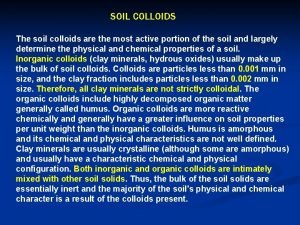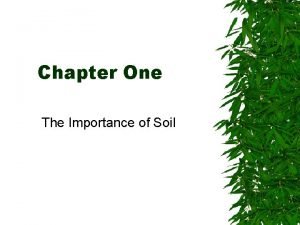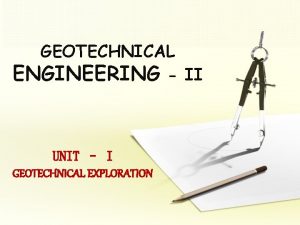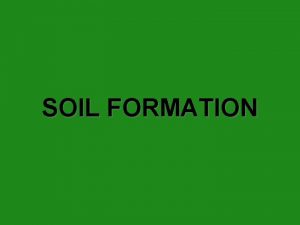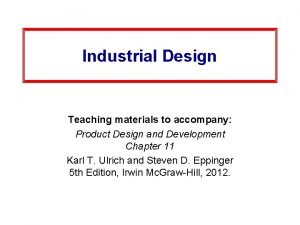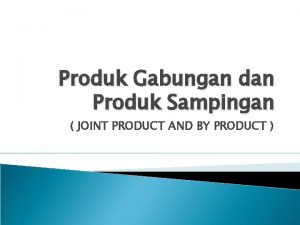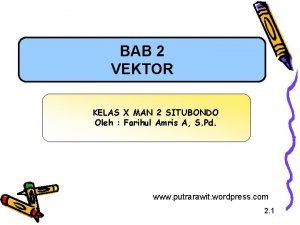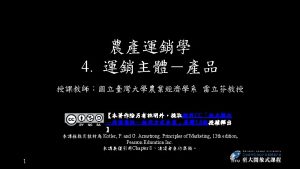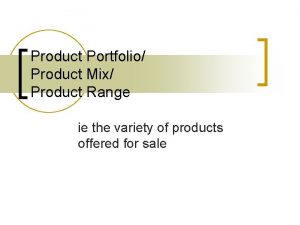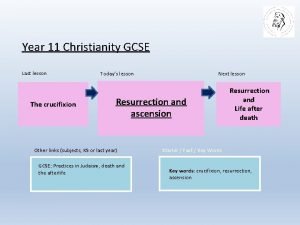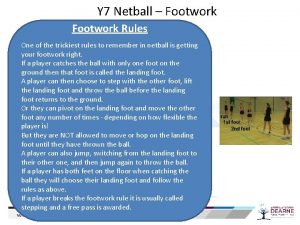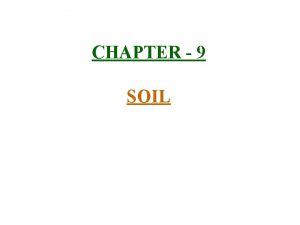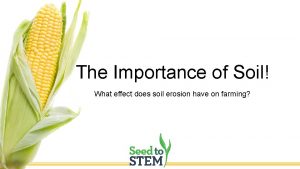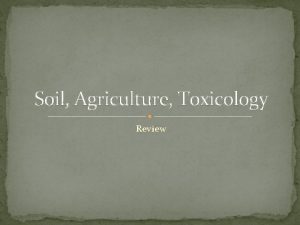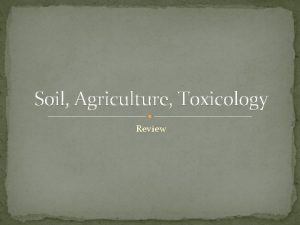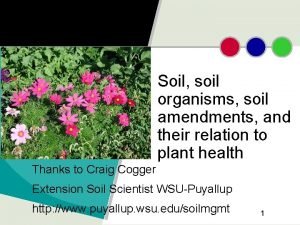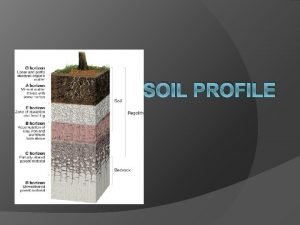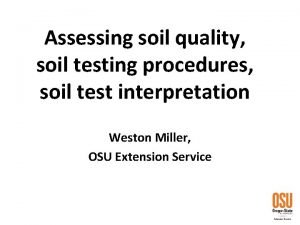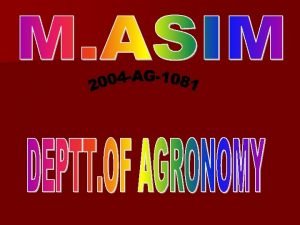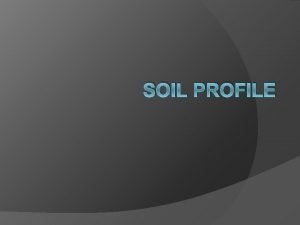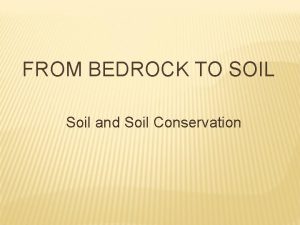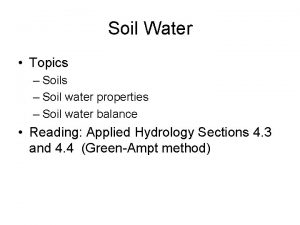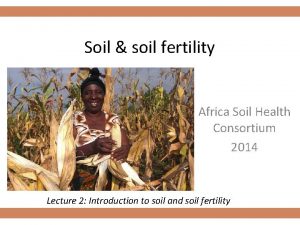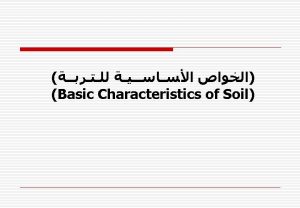Soil Importance of Soil An important product of






























- Slides: 30

Soil

Importance of Soil An important product of weathering Covers most land surfaces One of Earth’s most important resources

Characteristics of Soil is part of the regolith that supports the growth of plants. • Regolith is the layer of rock and mineral fragments that covers most of Earth’s land surface.

Soil Composition • Soil has four major components: 1) Mineral Matter-broken down rock 2) Organic Matter-HUMUS-the decayed remains of organisms 3) Water • Provides the moisture for chemical reactions to occur that sustain life 4) Air • Source of Carbon Dioxide plants use to produce sugar during photosynthesis

Composition by Volume of Good Quality Soil

Characteristics of Soil Texture • Texture refers to the proportions of different particle sizes. - Sand (large size) - Silt - Clay (small size) • Loam (a mixture of all three sizes) is best suited for plant life. • Sandy soils may drain out and dry too quickly • Clay rich soils drain very slowly

Soil Texture

Soil Characteristics Soil Structure • Soil particles clump together to give a soil its structure. • Determines how quickly soil can be cultivated and how susceptible it is to erosion • Affects how easily water penetrates soil

Soil Formation The most important factors in soil formation are: 1. Parent material 2. Time 3. Climate 4. Organisms 5. Slope

Soil Formation Parent Material Time Source of mineral matter Residual Soil- parent material is the bedrock The longer a soil has been forming, the thicker it becomes Transported Soil- Parent material has been carried from elsewhere and deposited by gravity, water, wind, or ice Parent material mostly determines characteristics of young soils Influences on Soil As time and weathering continues, the influence of parent material decreases 1. Affects the weathering and rate of soil formation 2. Affects Soil fertility (what kind of plants it can support)


Soil Formation Climate Organisms Greatest effect on soil formation Type and how many affect soil’s physical and chemical properties Different temperatures and moisture affects rate, depth, and type of weather In the same amount of time: Hot, wet climate: thick layer of chemically weathered soil Cold, dry climate: thin layer of mechanically weathered soil Amt of Precipitation influences soil fertility; rate at which nutrients are removed from soil Affects types of organisms that can live on and in the soil Plants are main type of organic matter in soil; contributes to soil fertility (remember humus) Microorganisms decompose dead plants and animals Burrowing animals mix the organic and mineral matter and help water and air penetrate into the soil

Soil Formation SLOPE: On steep slope Erosion is accelerated Often have poorly developed soils because little water can soak in and cant hold moisture for plant growth Flat areas Little erosion and poor drainage Optimum slope Flat-to-undulating upland surface

The Soil Profile Soil varies in composition, texture, structure, and color at different depths. Soil horizons are zones or layers of soil. A soil profile is a vertical section through all the soil horizons. • The A horizon is commonly know as topsoil. • The B horizon is subsoil and contains clay particles washed out from the A horizon. • The C horizon is between B horizon and unaltered parent material.

Soil Profile

Soil Types Three common types of soil are pedalfer, pedocal, and laterite. 1. Pedalfer • Best developed under forest vegetation • Usually forms in temperate areas that receive >63 cm/year (Mostly Eastern States) • Accumulation of iron oxides and aluminum-rich clays in the B horizon • Remember Al=aluminum & Fe=Iron on Periodic table (ped. Al. Fer) • Brown to red-brown in color

Soil Types Pedocal Laterite Accumulates calcium carbonate Hot, wet, tropical climates Associated with drier grasslands Intense chemical weathering Found in drier western United States Large amount of water removes most of the calcite and silica Contain less clay than pedalfers because of drier climate and less chemical weathering Iron Oxide and Aluminum oxide are left behind Light gray-brown color Orange-red color

Soil Erosion Water erodes soil. HOW? Rates of Erosion • Human activities that remove natural vegetation, such as farming, logging, and construction, have greatly accelerated erosion. • Wind vs Water? Which do you think erodes quicker? Sediment Deposition • Another problem caused by excessive soil erosion • Reservoirs fill with sediment. • Sediments are contaminated by pesticides and fertilizers.

Controlling Erosion • • Planting rows of trees called windbreaks Terracing hillsides Plowing along the contours of hills Rotating crops

Mass Movements

Triggers of Mass Movements The transfer of rock and soil (regolith) downslope due to gravity is called mass movement. Among the factors that commonly trigger mass movements are saturation of surface materials with water, oversteepening of slopes, removal of vegetation, and earthquakes.

The Role of Gravity Shear stress is the force of gravity acting on an object on a slope always pulls straight down, perpendicular to the horizon objects move downhill at some angle

Resistance to Movement Cohesive strength-the resistance of an object to move downhill Friction Cohesion, stickiness of particles Other forces holding a particle in place (plant roots, cementation)

The Role of Water may act to increase or decrease cohesive strength Dry regolith or soil has little or no cohesion Damp regolith or soil is sticky Saturated regolith or soil flows easily

Types of Mass Movement Classified by Type of motion Type of material Rate of movement

Types of Mass Movements Geologists classify mass movements based on the kind of material that moves, how it moves, and the speed of movement. Rockfalls • A rockfall occurs when rocks or rocks fragment fall freely through the air. • Sometimes triggers other mass movements

Types of Mass Movements Slides • In a landslide, a block of material moves suddenly along a flat, inclined surface. • Slides that include segments of bedrock are called rockslides. Slumps • A slump is the downward movement of a block of material along a curved surface.

Heavy Rains can Trigger Slumps

Types of Mass Movements Flows • Flows are mass movements of material containing a large amount of water. • Mudflows move quickly and carry a mixture of soil, rock, and water that has a consistency of wet concrete. • Earthflows move relatively slowly and carry clay-rich sediment.

Types of Mass Movements Creep • Creep is the slow, downhill movement of soil and regolith. This is the slowest type of mass movement.
 Newspaper article format
Newspaper article format Inverted pyramid in news writing
Inverted pyramid in news writing Least important to most important
Least important to most important Colloids are important to soil formation because
Colloids are important to soil formation because Living soil vs dead soil
Living soil vs dead soil Living soil vs dead soil
Living soil vs dead soil Importance of soil
Importance of soil Outside clearance of soil sampler
Outside clearance of soil sampler What is in soil
What is in soil Soil textural triangle practice exercises
Soil textural triangle practice exercises Limited product availability
Limited product availability Level of product availability
Level of product availability Importance of product design
Importance of product design New product development and product life cycle strategies
New product development and product life cycle strategies By product dan joint product
By product dan joint product Marginal product and average product
Marginal product and average product Product mix and product line
Product mix and product line Core product actual product
Core product actual product Dot product vs cross product
Dot product vs cross product Management prowess example
Management prowess example What is product line depth
What is product line depth Lima buah vektor digambarkan sebagai berikut
Lima buah vektor digambarkan sebagai berikut Core actual and augmented product
Core actual and augmented product Dogld
Dogld Rumus yang menyatakan cross-product adalah
Rumus yang menyatakan cross-product adalah Gnp and gdp
Gnp and gdp Crucifixion quotes gcse
Crucifixion quotes gcse Footwork in netball
Footwork in netball Items that distort or prevent communication
Items that distort or prevent communication Objectives work immersion
Objectives work immersion Why experience is important
Why experience is important



